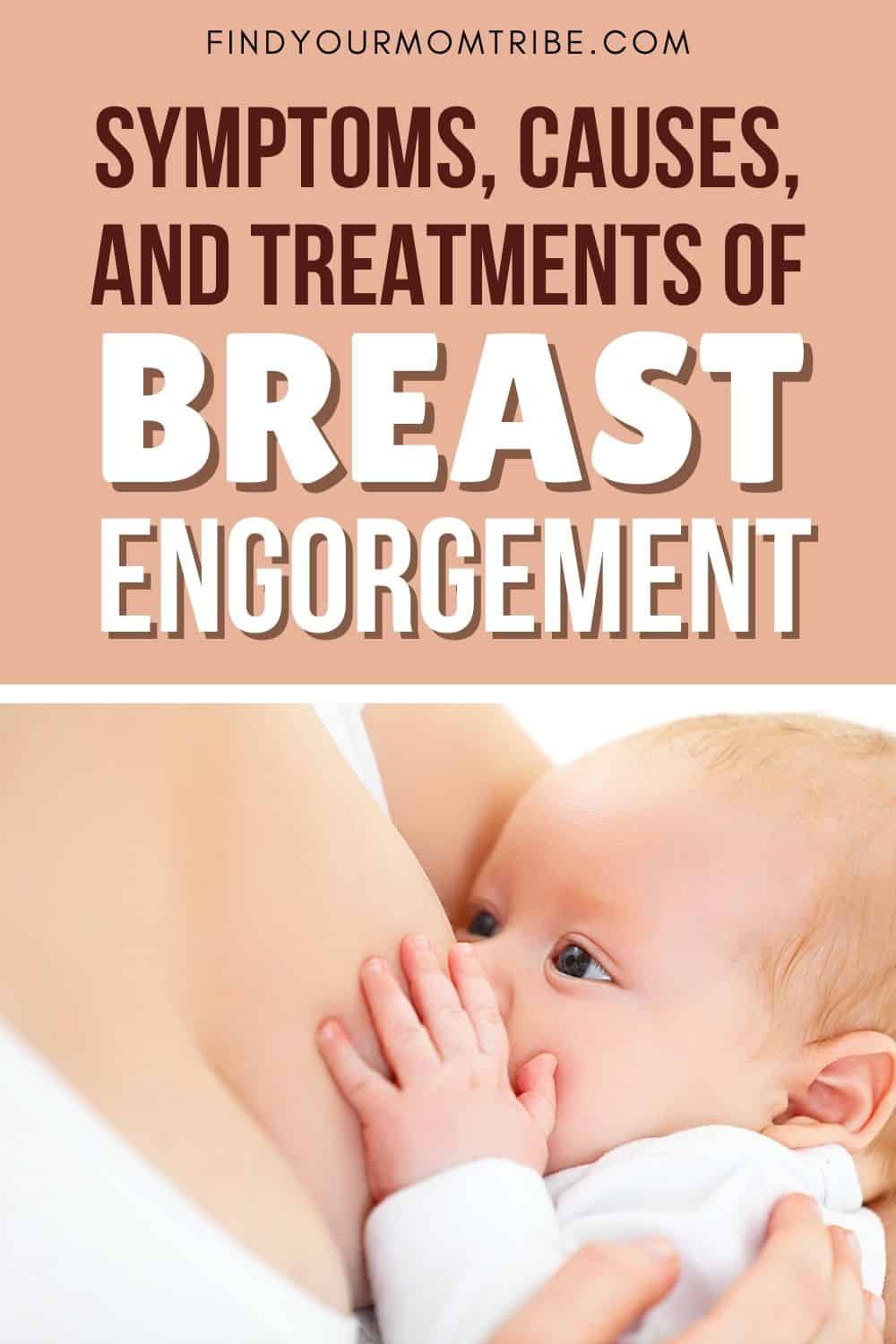Breast engorgement is a well known and rather common condition that affects a lot of mothers during the first few days after they give birth to their child.
When you’re affected by breast engorgement, your breasts will feel swollen, the skin on your breasts tightens up and starts feeling painful, and your nipples become flatter and tougher than usual.
Your entire chest wall is going to feel tighter and your breasts, especially, will be heavier, causing you a lot of pain over the affected area, sometimes even all the way up to the armpit.
Luckily, this period is temporary and lasts only a few days, two weeks at worst if you do nothing to prevent or treat it, but you may have a very cranky baby on your hands during this period.
The reason is that a flattened nipple is a lot harder to latch on to.
Your baby needs to get enough milk during these first few weeks to keep up with a regular developmental cycle and engorgement is one of the largest culprits of a reduced milk intake.
There are some other issues that may arise from engorged breasts such as mastitis, clogged milk ducts and a range of breast infections as well as abnormalities in your milk production, but more on that a bit later.
Breast Engorgement Symptoms

It’s relatively easy to spot when your breast becomes engorged as you’ll have both visual and sensory cues, so spotting them late won’t ever really happen. Some of the most common symptoms include:
Hardness of the breast: When your breast starts becoming a lot stiffer/tougher and moving around becomes painful, it’s one of the most clear-cut signs that you may be suffering from breast engorgement.
Stretched, almost glossy skin: When the breast becomes engorged and its volume increases, it’s only natural that the skin will stretch itself out to accommodate. As that happens, you won’t see much of a texture on it, but rather a smooth, sensitive layer.
Tenderness of the breast tissue: The chest area, in its entirety, becomes a lot more sensitive to both touch and pain. Any sort of applied pressure will be felt as an uncomfortable jolt or pang. In the most severe cases, you’ll even be able to feel it up to your armpits.
Flatter nipples: As breast engorgement occurs, one of the main symptoms that ends up causing the most trouble is the fact that your nipple area becomes flatter. Your areolas widen and the nipple itself becomes a lot tougher and less flexible, harder to latch onto or stretch out.
Abnormal milk production: This is a given when it comes to engorged breasts, but, after the first breastfeed finishes and the colostrum is out, you’re likely to be producing more milk than your breasts have to.
The latter problem might be that you’re not expressing enough milk to empty your breasts out fully which later becomes a problem.
A low-grade fever: When you’re suffering from severe engorgement, you may even start feeling as though you’re suffering from a bit of a fever or even experience flu-like symptoms.
What Causes Breast Engorgement

There aren’t too many causes of breast engorgement and they mostly boil down to the main three:
Expressing milk too often: While it’s nice to keep your fridge stocked with bottles of breast milk you might not know that the more milk you express, the faster your breasts will start to fill back up.
This, in turn, leads to an increase in overall milk production which ends up making the engorgement problem worse instead of helping relieve it.
Make sure to exercise caution when pumping breast milk on top of your existing breastfeeding schedule and you should be able to avoid this issue.
Hormones acting up: The fact that every person is a unique individual means that sometimes we have great characteristics, and occasionally we’re stuck with some bad ones.
We’re all born with different genes and sometimes a slight mix-up can happen where we end up being more prone to a number of issues, in this case, breast engorgement.
Some women tend to have more active hormones in their mammary glands which leads to them producing a lot more breast milk in their milk ducts at a faster rate which, if not drained properly by the baby, will lead to engorgement, mastitis, or clogged milk ducts.
It’s a fact that sadly affects many women and the worst part is that there’s little they can do about it besides being ready to treat the issue quickly to reduce its impact on their day-to-day lives.
Irregular feeding times: Confusing your inner biological clock is the worst thing humans can do to themselves.
Our bodies are made to run on certain routines and any shifts to those routines cause an unwanted amount of stress that can lead to a number of complications: insomnia, illness, overall tension, acute pain, digestive disorders, and, in our case, breast engorgement.
When you start straying away from the initial schedule that you had set your body up for, your brain is going to get confused about when exactly it is meant to send the signal to the milk ducts to start producing milk and will instead start working overtime.
This usually leads to an overabundant increase in milk supply and overall milk production which comes rushing through the breast like a dam that has just burst but has nowhere to go, lingering in the breast and making it swell up, leading to this problem of engorgement.
The change in schedule usually develops because the baby isn’t hungry all of a sudden and that is most often the case when mothers start introducing other foods and liquids, such as water, into the mix.
While safe for the baby, you should keep them strictly on breast milk unless there’s some underlying medical issue that makes you have to act otherwise.
This way, they’ll get used to it and will be able to develop from the nutrients in the breast milk alone, and you’ll be able to keep your body in the routine that it’s used to without having to worry about any sudden changes (hopefully).
How Long Does Engorgement Last

One more thing to note is that while the issue of engorged breasts usually affects women during their child’s early days, it can happen during any point while they’re still breastfeeding due to these causes in particular.
It always tends to last about the same amount of time, anywhere between a few days to two weeks depending on how well you treat it.
Treating Breast Engorgement

Thankfully, when breast engorgement does occur, it’s rather easy to treat, you just have to know how.
Most of the answers on how to relieve engorgement are simple enough to do at home without the need to involve your doctor or any other healthcare professional.
Some of the most common ones are:
Milk expression: The best way to solve the problem of breast engorgement is to hand express a little milk by yourself to help loosen up the nipple.
This will make it easier for your little one to latch on to it and empty the rest of your breast without wasting any more precious liquid gold.
Breast massages: A similar method to help relieve the tenderness and pain of your breasts being engorged is to gently massage them to help loosen up the breast tissue.
It will provide a dose of instant relief and may help you breastfeed more easily, as well as go about the rest of your day without having to deal with the pain.
Wearing loose clothing: Yes, tight clothing can also play a role in causing breast engorgement, or more accurately mastitis or clogged milk ducts, as your breasts simply don’t have room to breathe and their milk flow becomes irregular.
This especially goes for bras. Look for loose, more supportive bras or lose the bra all together when you’re at home, just to give your breasts a bit of relief that they might not get during a busy day.
Taking warm showers: Applying warm water to your breasts will help open pores up and help the breast tissue breathe, as well as help in moving things along inside the breast in case of a clogged milk duct.
Not to mention that warm showers are also known to aid in providing a better let down reflex.
One thing to keep in mind though is to never directly spray the warm water on your breasts as that will only make the problem worse.
Reverse pressure softening: Reverse pressure softening is a technique, usually performed by your lactation consultant or some form of healthcare provider, where they help soften the area around the nipple and the areola by using interstitial fluid.
While it can be taught to mothers so that they can perform the procedure themselves, I’d still personally suggest asking a doctor to do it for you.
Using an electric breast pump as a treatment option: If you’re a working mom and can’t get a regular feeding pattern in, consider filling the void during working hours by using an electric pump at a low setting until you drain the breast to simulate a breastfeeding session.
Using a cold compress: A cold compress or ice packs can help reduce the swelling of the breast just as easily as a warm shower can, though it’s much more accessible than the latter.
If you’re due for a feeding session, quickly grab one out of the fridge or freezer 20-30 minutes prior to it and place it on your breast to provide temporary but instant relief so you can get through the feeding session with little issue.
Utilizing natural remedies: If you’re someone who prefers alternative sources of comfort, you may want to try peppermint oil or even cool cabbage leaves to help against the swelling.
For the peppermint oil, simply lather it onto the breast and the swelling should drop rather quickly.
For the cabbage leaf option, simply place a leaf on each breast with a small cutout for your nipple to remain free and keep it on until it starts to look like it’s wilting. Replace it with a new leaf until you feel better. It usually takes somewhere around 30 minutes for it to take effect.
Do be careful with these two though as overuse may reduce your overall breast milk supply more than you’d want it to and then you will have a different problem to that of breast engorgement.
Using an anti-inflammatory drug: This one, while effective in helping reduce pain and swelling, isn’t to be taken without first advising with your lactation consultant or your healthcare provider.
Ibuprofen is one of the most common anti-inflammatory drugs, but again, should not be utilized of your own volition.
How To Prevent Breast Engorgement From Happening In The First Place

After having to deal with engorged and painful breasts during your first week of pregnancy, you may want to completely prevent the problem rather than having to deal with the symptoms again.
There are a few ways you can go about this, all of which should be followed if you want the prevention measures to be as effective as possible:
Keeping to a regular feeding schedule: Arguably one of the most important measures you can take. Your body, or your breasts in this case, works on a routine.
If you make this routine regular, there will be little to no breastfeeding problems that occur.
The moment a change happens, the body gets confused and tries to find some sort of rhythm, and that’s what causes engorgement in the first place.
In the early days, feed your newborn only breast milk: Doing this will make it easier to maintain a regular feeding schedule and help you deal with breast engorgement efficiently.
Wear looser clothing: Both a treatment and a prevention method, wearing loose clothes overall is going to help in letting your breasts breathe and not restrict blood flow, which will also end up preventing further complications like that of mastitis and blocked ducts.
Maintain a proper latching position: This will greatly help in preventing future breast-related issues from developing.
It’s just a matter of finding the position that works for both you and your baby.
First, hold your baby in such a way that his spine is in line with his neck and head.
Next, what you want to do is make sure to slowly bring his little head close to your breast and let him open his mouth of his own volition. This will teach him how to do it on his own later on down the line.
Then you must allow his lips to finally connect to your breast. Make sure they go around the nipple and that his mouth is firmly attached to the breast.
Also, make sure that your little one has his nose free to be able to breathe properly during breastfeeding sessions and check that his chin is resting on your breast so he doesn’t have to exert too much effort in keeping his head up and getting tired too quickly.
The rest of it is up to you, find a position in which you can support the rest of his weight.
This way, the baby has only to spend his energy on sucking on your breast and not much else while still having enough room to maneuver his head into a more desirable position.
Complications That Can Develop

There are two major complications that can occur with untreated or serious breast engorgement and that’s either mastitis or clogged milk ducts.
Mastitis is a condition where you develop a swollen area near the breasts that becomes inflamed and ends up filling with pus, something you’ll need to get punctured and drained properly to prevent any breast infections from occurring. Yeast infections tend to be particularly nasty.
Mastitis in and of itself also further influences the development of the other complication, the clogged milk duct, as it pushes the ducts closer to one another and squeezes them together if the pus-filled pocket ends up being in a rather uncomfortable area.
And I don’t think that clogged milk ducts need more explanation since the term is self-explanatory. This happens when there’s something blocking the milk ducts which causes further milk buildup due to the existing backlog.
Rather painful and only a further instigator of breast engorgement.
If any of these occur, make sure to go to your doctor immediately for help and to seek more precise measures that you can take to help relieve the symptoms that come from these two issues.
In Conclusion
Breast engorgement can be a rather nasty piece of work despite not really resulting in any permanent problems, though it won’t help your child and you’re bound to have many sleepless nights as soon as your child notices a change in your milk production.
Of course, there are also problems that come alongside it that affect you, mainly a lot of pain, both dull and burning, discomfort, and general unease as you feel stunted in your day-to-day actions.
Thankfully, remedies exist, both natural and pharmaceutical that can aid in resolving the issue quicker, though should any complications arise, you should always first consult your doctor or healthcare provider before anything else.
While all this advice is fine, nothing beats a professional who has hands-on experience and can diagnose your symptoms properly.
And, naturally, prevention is easier and all the steps should be followed if you wish to reduce your chances of breast engorgement as best you can, however, be aware that even then there still exists a small chance, depending on your genetics, that you may get affected regardless.
Just be sure to stay strong and persevere through it, it will only affect you while you’re still breastfeeding and then everything should be back to normal soon enough.
Like this post? Please share or pin it for later. You can also stay in the loop and follow us on Facebook, Instagram and Pinterest.

This post contains affiliate links. Please see our full disclosure or more info.

